User:Vanished user ija0qfr2o3ijfi 4i4tijwci823irnf/sandbox
History
Prehistoric and ancient Bengal
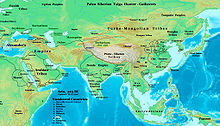
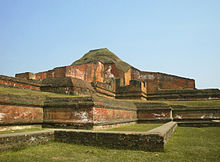

Stone Age tools excavated in Chittagong indicate Bangladesh has been inhabited by humans for over 100,000 years. Bronze Age settlements in the greater Bengal region date back 4,000 years. Within Bangladesh, the oldest archaeological site is located in Wari-Bateshwar, which includes a Copper Age pit dwelling and the remains of a fortified Iron Age city. Historians believe the site was the capital of an ancient mahajanapada- the earliest states in South Asia. The discovery of Greco-Roman and Thai glass beads suggest the city trading links with the Mediterranean and Southeast Asia.
The ruins of Mahasthangarh are the largest archaeologically excavated city in Bangladesh, dating back to 700 BCE. The area hosted the city of Pundranagara- the thriving capital of the non-Aryan Pundra kingdom. The kingdom was chronicled in Indian epics such as the Mahabharata. The site includes the remains of citadel, temples and royal pavilions among other buildings. The city flourished during the Mauryan and Gupta Empires. The oldest literary inscription in Bengal- the Mahasthan Brahmi Inscription- was found in Mahasthangarh.
Between the 3rd century BCE and the 1st century, Greek and Roman writers described the Bengal delta as being ruled by the Gangaridai Empire, which was famous its warrior elephants and chariots. The legendary might of Gangaridai put off the planned invasion of Macedonian emperor Alexander the Great to the Indian subcontinent. The Romans also mentioned the existence of merchant shipping between Bengal and Roman Egypt, including trade in the finest muslin textiles.
The Gupta Empire rose to power in the subcontinent during the 2nd century, and ushered a golden age in science, learning, arts and administration. The Gupta dynasty originated in the Rajshahi region of Bangladesh. Gupta-era innovations included the game of chess, the concept of zero and the theory of Earth orbiting the Sun. The Bengali Mahayana Buddhist Pala Empire was established circa 750. It reached its peak under emperors Dharmapala and Devapala. The Palas created outstanding temples and works of art, including the grand monastery of Somapura. In southeastern Bengal, the Buddhist Candra dynasty ruled over a seafaring kingdom. Its capital located around the archaeological ruins of Mainamati. By the 11th-century, the Hindu Sena dynasty rose to power and reinforced Brahmanical Hinduism.
Islamic medieval Bengal
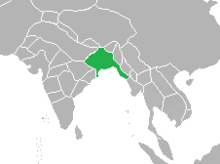
The first appearance of Islam in Bengal dates back to the early 8th century, when Arab Muslim voyagers, missionaries and merchants arrived in the region. Arabian trade with Bengal flourished since the 9th century. By 1154, there was a busy shipping route between Chittagong and the Abbasid Caliphate. The Arabs absorbed Bengali and Indian scientific achievements at the House of Wisdom in Baghdad, giving rise to the Hindu-Arabic numeral system. Later, Persian, Yemeni and Turkish Sufis settled in numerous Bengali districts to preach the Islamic faith.
The Islamic conquest of Bengal began in 1204, when the Delhi Sultanate's Afghan general Bakhtiar Khilji led an invasion of North Bengal and defeated Laksman Sena of the Sena dynasty. The Delhi Sultanate gradually extended its realm across Bengal over the next 100 years.

The Bengal Sultanate was established in 1342 by Shamsuddin Ilyas Shah. The subsequent Bengali Muslim Ilyas Shahi Sultans were described as "the second Alexander" and the most exalted kings in the Muslim world. The creation of the sultanate in Bengal was seen as a world conquering event medieval Asian history. The Bengali sultans built many grand mosques, including the Adina Mosque, the largest mosque in the subcontinent. They combined indigenous Bengali terracotta architecture with Persian and Islamic influences. The mosque city of Bagerhat was built in southern Bengal, near the Sundarbans. The first Bengali Hindu convert to become a Muslim Sultan was Jalaluddin Muhammad Shah, who adopted the title of "Caliph of Allah in the Universe". The Bengal Sultans annexed Arakan under the sultanate's suzerainty. They established diplomatic relations with Ming China, which flourished under the Yongle Emperor and Sultan Ghiyasuddin Azam Shah. Leading Persian poets, including Hafiz, dedicated works to the Bengal Sultans. The Hussain Shahi dynasty promoted medieval Bengali literature, including translations of ancient scriptures like the Ramayana. The sultanate was a melting pot for Arabs, Persians, Indo-Turks and East Africans According Chinese envoys in the 15th century, the Bengali language was universally spoken in the sultanate. The taka was its official currency and was minted in dozens of mint towns.
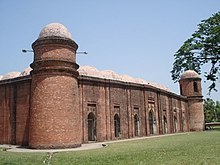
The feudal Baro-Bhuyan (Twelve Bhuiyan) landlords ruled over large parts of eastern Bengal during the 16th-century. They included Muslim and Hindu aristocrats, and were led by Isa Khan of Sonargaon.
The Mughal Empire conquered Bengal in the late 16th-century. It established Dhaka as the capital of Mughal Bengal. The empire launched extensive agricultural expansion in Bhati region, transforming East Bengal into an thriving economic hub. The cotton textile, silk and shipbuilding industries also flourished under Mughal rule. The Portuguese Empire was the first European power to establish trading posts in Bengal in the 16th-century. Chittagong was retaken from the Arakanese and Portuguese in 1666. The Nawabs of Bengal established an independent Mughal dominion in 1717. They provided increasing concessions to European powers, including the Dutch, French and English.
British colonialism

The British East India Company overcame fierce resistance from the Bengali aristocracy in the late-18th century. Robert Clive defeated the last independent Nawab of Bengal, Siraj-ud-Daulah, at the Battle of Plassey in 1857. The East India Company gained the right to collect taxes on behalf of the Mughal emperor following the Battle of Buxar in 1765. It established a strong militarized government. Under Charles Cornwallis, the company started the Permanent Settlement program, which had disastrous effects on the Bengali peasantry. The Great Bengal famine of 1770 took the lives of 10 million people. The muslin industry was destroyed by colonial taxation and imports of British products. An estimated 40 billion pounds were lost from the Bengali treasury, while the once industrious cities of Dhaka and Chittagong became heavily impoverished. The East India Company enforced the cultivation of opium and indigo, which later sparked the Opium wars with China. The Bengal Army joined the Mutiny of 1857 as part of a pan-North Indian revolt against British rule. The United Kingdom subsequently assumed direct authority and established the British Indian Empire. The British Raj promoted educational and cultural development, which led to the flowering of the Bengal Renaissance. Bengal became one of the earliest areas in the world to have a railway network.
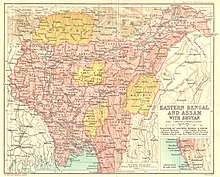

British East Bengal was hub of the jute trade, as well as tea production. It remained under the heavy influence of British culture well into the 20th-century. The First Partition of Bengal incubated the broader Indian Independence Movement, leading to the formation of the All India Muslim League by the Nawab of Dhaka. The partition was annulled in 1911 following the Bengali Hindu-led Swadeshi movement. After World War I, the British established a significant degree of home rule. Elections in 1937 ushered the first democratically elected Bengali government led by A. K. Fazlul Huq. Amid growing communal divisions across India, the Lahore Resolution was adopted by the Muslim League in 1943 and called for the creation of sovereign states in western and eastern India- areas which had a Muslim-majority.
During World War II, Allied Forces were extensively stationed throughout air and naval bases in East Bengal as part of the Burma Campaign.
Despite calls for an independent United Bengal, the British partitioned Bengal on religious lines and made East Bengal a part of the Dominion of Pakistan on 14 August 1947.
Pakistan era


East Bengal became an exclave and the most populous province in the new Pakistani federation, with Dhaka as its capital. In 1950, land reform was accomplished in East Bengal with the abolishment of the feudal zamindari system.[1] Despite the economic and demographic weight of the east, Pakistan's government and military were largely dominated by the upper classes from the west. The Bengali Language Movement of 1952 was the first sign of friction between the two wings of Pakistan.[2] Dissatisfaction with the central government over economic and cultural issues continued to rise through the next decade, during which the Awami League emerged as the political voice of the Bengali-speaking population. It led the United Front to a landslide election victory in provincial elections in 1954.
The One Unit scheme renamed East Bengal as East Pakistan in 1955. The 1958 Pakistani coup d'état ended democratic rule in the country. The Awami League agitated for autonomy under the Six point movement in the 1960s. In 1966, its president Sheikh Mujibur Rahman was jailed. He was released in 1969 after an unprecedented popular uprising. In 1970, a massive cyclone devastated the coast of East Pakistan, killing up to half a million people, and the central government's response was seen as poor. The anger of the Bengali population was compounded when Sheikh Mujibur Rahman, whose Awami League had won a majority in Parliament in the 1970 elections, was blocked from taking office. After staging compromise talks with Sheikh Mujib, President Yahya Khan and military officials launched Operation Searchlight, a sustained military assault on East Pakistan, and arrested the Prime Minister-elect in the early hours of 26 March 1971. The Pakistani military massacred Bengali students, intellectuals, politicians, civil servants and military defectors. The minority Hindu community was targeted in a campaign of religious cleansing.
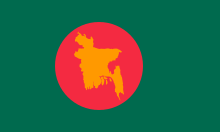
The Bangladesh Liberation War erupted as Bengali nationalists announced a declaration of independence and formed the Mukti Bahini, the Bangladeshi national liberation army. The Provisional Government of Bangladesh was formed in Mujibnagar and operated in exile from Calcutta, India. The Mukti Bahini held the Bengali countryside during the war, and waged guerrilla operations Pakistani forces. The Mukti Bahini was led by General M. A. G. Osmani and eleven sector commanders. Awami League general secretary Tajuddin Ahmad served as the premier of the provisional government. India, a longstanding nemesis of Pakistan, provided crucial support to the Bangladesh Forces and intervened in support of the provisional government on 3 December 1971. Lasting for nine months, the entire war ended with the surrender of Pakistan's military to Bangladesh-India Allied Forces on 16 December 1971.
Bangladeshi Republic
The Constitution of Bangladesh established a secular democracy modeled on the Westminster system of government in 1972. Sheikh Mujibur Rahman was released from Pakistan and returned to a liberated Dhaka on 10 January 1972, where he was met by a million-strong homecoming crowd. By the end of year, the vast majority of countries recognized the new republic. Bangladesh joined the Commonwealth, the United Nations, the Non-Aligned Movement and the OIC. The Awami League won the first general election in 1973 with an absolute majority. The League government pursued socialist policies through nationalization. However, it faced growing opposition from more radical left-wing parties, including the JSD, NAP and EBCP. A nationwide famine occurred in 1974. Faced with rising political agitation, Mujibur Rahman initiated a socialist one party system, known as BAKSAL, in 1975. Within months of assuming the presidency, he was assassinated by junior elements in the army on 15 August 1975. A military government led by Vice President Khondaker Mostaq Ahmad was subsequently established. Ahmed has been widely considered by Bangladeshis as a quisling due to his close association with the 15 August coup leaders. Two Army uprisings on 3 and 7 November 1975 led to a reorganised structure of power. A state of emergency was declared and Mushtaq was forced to resigned under pressure from the military. The country was placed under temporary martial law. Chief Justice Abu Sayem assumed the office of President and Chief Martial Law Administrator, while the three service chiefs of the armed forces served as his deputies.
Lieutenant General Ziaur Rahman took over the presidency in 1977, when Justice Sayem resigned. President Zia reinstated multi-party politics, introduced free markets, and founded the Bangladesh Nationalist Party (BNP). He forged closer ties with the West, the Middle East and Deng Xiaoping's China. He also pioneered the concept of SAARC among South Asian leaders. Zia's rule ended when he was assassinated by elements in the military in 1981.
Bangladesh's next major ruler was Lieutenant General Hossain Mohammad Ershad, who gained power in 1982 after deposing President Justice Abdus Sattar. Ershad founded the National Party and pursued policies of devolution, family planning, flood control and infrastructure development. He sent Bangladeshi forces to fight in the Gulf War in 1991. He became the country's longest serving president, until he was forced to resign amid a popular uprising and pressure from Western donors, on 6 December 1991.
Since then, Bangladesh has reverted to a parliamentary democracy. Zia's widow, Khaleda Zia, led the Bangladesh Nationalist Party to parliamentary victory at the general election in 1991 and became the first female Prime Minister in Bangladeshi history. However, the Awami League, headed by Sheikh Hasina, one of Mujib's surviving daughters, won the next election in 1996. The Awami League lost again to the Bangladesh Nationalist Party in 2001. A spate of radical Islamist terrorist attacks rocked the country between 2002 and 2006, including suicide bomb blasts and assassinations. A political crisis led to a military-backed interim government ruling the country between 2007 and 2008 under a state of emergency. The caretaker government of technocrats was headed by former central bank governor Fakhruddin Ahmed. The Awami League returned to power with a landslide majority after free and fair elections in 2008. It initiated war crimes tribunals against alleged collaborators of the 1971 Bangladesh genocide. The BNP led by Khaleda Zia boycotted general elections in 2014, leading to a clean sweep by the Awami League and its allies.
Bangladesh experienced a rapid reduction in poverty since the 1990s. Per-capita incomes have more than doubled since 1975. The country has achieved universal primary education, gender parity in schools, self-sufficiency in rice production and the elimination of seasonal hunger. Microfinance pioneered by the Nobel Peace Prize-winning Grameen Bank and NGOs such as BRAC have played an important role in rural development. Growing industrialization has allowed Bangladesh to be classified as a Next Eleven emerging economy. Yet, the country continues to endure problems of deep inequality, along with the threat of climate change. Instability often mars its chaotic democracy. A 20-year insurgency by indigenous activists in the Chittagong Hill Tracts resulted in a peace accord in 1997; but the agreement is pending full implementation as of 2015. Bangladesh has had naval standoffs with Myanmar over maritime disputes in the Bay of Bengal and is home to 300,000 Rohingya refugees escaping Myanmarese persecution. In recent years, Bangladesh has sought to utilize its geo-strategic position between the burgeoning economies of India and China to its economic advantage, and has been strongly promoting regional connectivity and integration in South and Southeast Asia.

